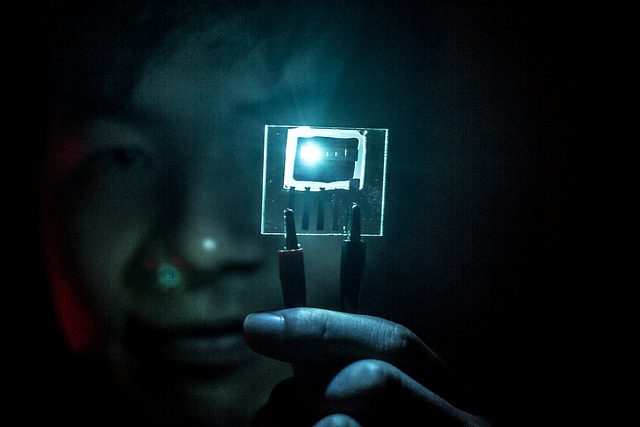Organic light-emitting diodes, or OLEDs, are the latest and greatest breakthrough in display screen technology. That’s because they provide vibrant colors and are extremely adaptable in the sense that they allow engineers to design screens that are thin and curved.

There are several different types of OLEDs on the market, and the one specific to this story is phosphorescent OLEDs, or PHOLEDs for short. PHOLEDs use a mechanism that is four times more efficient than fluorescent OLEDs to produce lights. Many red and green PHOLEDs are used in this mechanism, but the third color in the RGB trio, which makes up all OLED displays in smartphones and high-end TVs, is blue, and it does not show true color vibrancy when run through the same mechanism.
As a result, the blue OLED is not phosphorescent, but in fact, fluorescent.
“Having a blue phosphorescent pixel is an important challenge, but they haven't lived long enough,” said Stephen Forrest, the Paul G. Goebel Professor of Engineering at the University of Michigan. Forrest, together with a group of colleagues demonstrated the first PHOLED in 1998 and the first blue PHOLED in 2001.
Hi group’s latest breakthrough is a longer-lasting blue PHOLED. This not only results in better color / picture quality, it also means less power is being devoted to running two different lighting “types” (fluorescent and phosphorescent) within an LED trio.
“In a display, it would be very noticeable to your eye,” Forrest said.
Forrest’s group started working on a more efficient blue PHOLED in 2008, when they got together with researchers at Universal Display Corp. At that time, he proposed an explanation on why blue PHOLEDs lives were so short, saying that the high energies required to produce blue light are more damaging when the brightness is increased to meet the level of expectation in today’s display and lighting technologies.
Specifically, the group focused on the fact that a concentration of energy on one molecule can group up with that found in its neighbor, and the total energy from this collaboration is enough to break up one of the molecules.
This is less of a problem when it comes to red- and green-emitting PHOLEDs because it takes lower energies to make these colors. But a lot of energy was being devoted to, and subsequently wasted on, the blue PHOLEDs.
“That early work showed why the blue PHOLED lifetime is short, but it didn't provide a viable strategy for increasing the lifetime,” said Yifan Zhang, a recent graduate from Forrest's group who is first author on the new study. “We tried to use this understanding to design a new type of blue PHOLED.”
The group’s solution was to spread out the light-producing energy so that molecules are less likely to experience the bad synergy that destroys them.
Specifically, the blue PHOLEDs were placed on a thin film of light-emitting material sandwiched between two conductive layers (one for electrons and one for holes), with the positively charged spaces representing the absence of an electron. Light was produced when electrons and holes met on the light-emitting molecules, however, when the light-emitting molecules were spread out evenly, the energetic electron-hole pairs tended to accumulate near the layer that conducts electrons. This caused the same damaging energy transfers the group noticed in earlier versions of the blue PHOLEDs. So instead the group arranged the molecules in such a way that they would concentrate near the hole-conducting layer and sparser toward the electron conductor. Doing this, the team discovered, drew electrons further into the material, which spread the energy out and helped avoid the damaging synergy effect.
In terms of sheer numbers, this new distribution method extended the lifetime of the blue PHOLED by three times. To build this up a bit, Forrest’s group split the design into two layers in order to halve the concentration of light-emitting molecules in each layer. This, it turns out, increased the lifetime of the blue PHOLEDs tenfold.
“Our university research programs are a strong element of our effort towards solving critical OLED issues and accelerating the growth of the display and lighting industries,” explained Julie Brown, senior vice president and chief technical officer of Universal Display. “This exciting result by Professor Forrest and his team is an important step towards a full commercial phosphorescent RGB solution.”
The full research paper was published under the title “Ten-Fold Increase in the Lifetime of Blue Phosphorescent Organic Light Emitting Diodes”. It can be found in the publication, Nature Communications.
Advertisement
Learn more about Electronic Products Magazine





